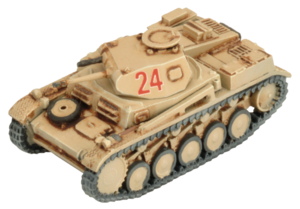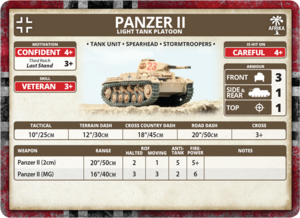Panzer II: Difference between revisions
1d4chan>Lord Of The Lemmings No edit summary |
m (11 revisions imported) |
||
| (10 intermediate revisions by 6 users not shown) | |||
| Line 1: | Line 1: | ||
The Panzer II was | [[File:Panzer II Mini.png|thumb|"2 can be as bad as one, the loneliest number since the number 1.."]] | ||
[[File:Pz II Luchs.png|thumb|From early failures can come later successes]] | |||
The '''Panzer II''' was an early tank design that served as the basis of the Wespe Self-Propelled Howitzer and the Marder II. It was the most numerous tank deployed during the Invasions of Poland and France. | |||
==Early War== | |||
[[File:Panzer II Statcard.png|thumb|left|Die Stats]] | |||
==Late War(Luchs)== | |||
[[File:Luchs Statcard.jpg|thumb|left|Die Stats]] | |||
Boasts better side armor and far greater range for a light tank including a greater ROF due to the autocannon, but overall a slight upgrade over the base Panzer II, but you can take it in late war! | |||
==IRL== | ==IRL== | ||
The Panzer II started out as a stopgap solution, originally developed to help German Industry gain its footing after the Great Depression. | The Panzer II started out as a stopgap solution, originally developed to help German Industry gain its footing once more after the Great Depression. Early Panzers (I, II, but also a few... [[derp|idiocies]] like the Neubaufahrzeug) allowed the German industry to gain experience producing tanks and build enough capital to start working on the Panzer III's and IV's... [[just as planned|all under cover of peaceful tractor development to fool the Western allies the treaty of Versailles was still being honored at the time.]] | ||
When they entered service in the early 1930s, the Panzer II was a solid light tank design: relatively fast and nimble, able to resist any AT gun that existed at that moment; its only real weakness was the puny 20mm cannon sported in the turret, that would only be useful against soft targets (like trucks). By 1939, while this advantage had somewhat eroded, they were available in great numbers and worked well with German Blitzkrieg tactics which favored mobility and initiative. By 1940 however, the writing on the wall was clear and all mainline variants were withdrawn following the battle of France, being either modified into tank destroyers/SPGs or only used for recon, sometimes in police/anti-partisan duty but mostly as training vehicles for new crews to get started on. | |||
About a | About a dozen variants and subvariants of the vehicle exist, including the abovementioned TD's (Marder II), SPG's (Wespe) but also flame tanks to support infantry. One of the more famous versions was the late-war Panzer II Ausf. L version, better known as "Luchs" (Lynx), which served as a recon vehicle with a 2cm autocannon strapped to it. Notably, it was able to achieve speeds of up to 60 KPH (37 MPH) and despite only 100 being built, the vehicle was popular among the crews that used them. | ||
{{Template:German Forces in Flames of War}} | {{Template:German Forces in Flames of War}} | ||
Latest revision as of 09:20, 22 June 2023


The Panzer II was an early tank design that served as the basis of the Wespe Self-Propelled Howitzer and the Marder II. It was the most numerous tank deployed during the Invasions of Poland and France.
Early War[edit]

Late War(Luchs)[edit]

Boasts better side armor and far greater range for a light tank including a greater ROF due to the autocannon, but overall a slight upgrade over the base Panzer II, but you can take it in late war!
IRL[edit]
The Panzer II started out as a stopgap solution, originally developed to help German Industry gain its footing once more after the Great Depression. Early Panzers (I, II, but also a few... idiocies like the Neubaufahrzeug) allowed the German industry to gain experience producing tanks and build enough capital to start working on the Panzer III's and IV's... all under cover of peaceful tractor development to fool the Western allies the treaty of Versailles was still being honored at the time.
When they entered service in the early 1930s, the Panzer II was a solid light tank design: relatively fast and nimble, able to resist any AT gun that existed at that moment; its only real weakness was the puny 20mm cannon sported in the turret, that would only be useful against soft targets (like trucks). By 1939, while this advantage had somewhat eroded, they were available in great numbers and worked well with German Blitzkrieg tactics which favored mobility and initiative. By 1940 however, the writing on the wall was clear and all mainline variants were withdrawn following the battle of France, being either modified into tank destroyers/SPGs or only used for recon, sometimes in police/anti-partisan duty but mostly as training vehicles for new crews to get started on.
About a dozen variants and subvariants of the vehicle exist, including the abovementioned TD's (Marder II), SPG's (Wespe) but also flame tanks to support infantry. One of the more famous versions was the late-war Panzer II Ausf. L version, better known as "Luchs" (Lynx), which served as a recon vehicle with a 2cm autocannon strapped to it. Notably, it was able to achieve speeds of up to 60 KPH (37 MPH) and despite only 100 being built, the vehicle was popular among the crews that used them.
| German Forces in Flames of War | |
|---|---|
| Tanks: | Panzer II - Panzer III - Panzer IV - Panther - Tiger - Tiger II - Panzer 38(t) - Captured Tank Platoon (Germany) |
| Transports: | SdKfz 250 - SdKfz 251 - Opel Blitzwagen |
| Infantry: | MG34 Platoon - AT-Rifle Team - Assault Pioneer Platoon - Grenadier Company - Fallshirmjager Company |
| Artillery: | PaK-40 Anti-Tank Gun - Hummel - Panzerwerfer 42 - Wespe - Grille - PaK-43 - 12cm Mortar - 8cm Mortar - 21cm Nebelwerfer 42 - 30cm Nebelwerfer 42 |
| Tank Destroyers and Assault guns: | Marder - StuG III - Jagdpanzer IV - Nashorn - Elefant - Jagdtiger - Brummbar - Hetzer - Sturmpanzer II Bison |
| Armored Cars: | SdKfz. 234/2 'Puma' - Sd.Kfz 222/223 - SdKfz. 231 |
| Aircraft: | JU-87 Stuka - HS-129 - ME-262 Sturmvogel |
| Anti-Aircraft: | Flak 88mm - Flakpanzer IV Wirbelwind & Ostwind |